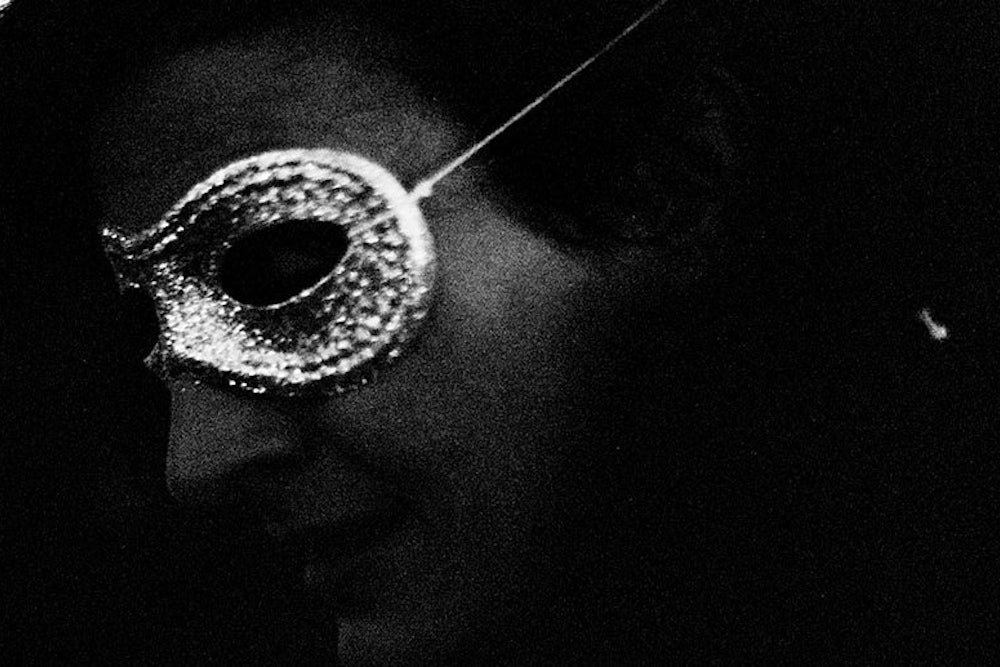Postmodernism is now a rather unmeaning term, dulled by overuse, and unfit to describe a new group of authors of varying ages and nationalities who are often lumped together under its umbrella: Ben Lerner, Sophie Calle, Teju Cole, Tom McCarthy, Alejandro Zambra, Siri Hustvedt, Michel Houellebecq, Sheila Heti, W.G. Sebald, Orhan Pamuk, and Enrique Vila-Matas, the sexagenarian Barcelona-based writer who, with over 20 novels to his name, is perhaps the most prolific yet least-known of them all.
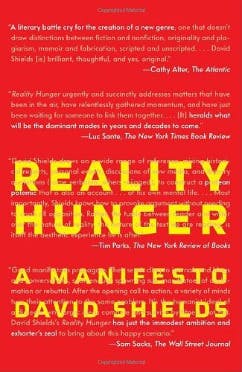
Call them, instead, the Reality Hunger generation, after David Shields’ ingenious and prophetic 2008 manifesto on contemporary writing. For Shields, novels that employ the traditional conventions of narration, plot, and story no longer make sense. Reality is fiction, and fiction is reality. For a more accurate reflection of how we experience this reality, we ought to think of novels the way we think about art. “A novel, for most readers—and critics—is primarily a ‘story,’” writes Shields. “But a work of art, like the world, is a living form. It’s in its form that its reality resides.” So if form is now all-important—more so than content—what is the form that contemporary works of art so often take? Collage. This also happens to be the form of Reality Hunger. In addition to outlining the future of artistic production, Reality Hunger doubles as a blueprint for it: It is a pastiche, a series of intentionally “plagiarized” aphorisms, presented without quotation marks. (The original sources are listed in the index for legal reasons, but Shields encourages the reader to cut them out of the book.)
But in the years since Reality Hunger was published, fiction has evolved and adopted its own post-Shields specificities. While all of these novelists (Lerner, Calle, Cole, etc.) are transparently their narrators, there tends to be a specter of trauma in the background as well: Zambra writes in the shadow of the Pinochet coup in Chile, Sebald excavates the memory of the Holocaust, and Lerner documents the aftermath of the 3/11 train bombings in Madrid. Above all, this genre is marked by its generic porousness, its willingness to embrace a collage of forms—Zambra’s Ways of Going Home and Lerner’s 10:04 become poems, while other novels dialogue with music and theater. Many of these novels include moments of essayistic prose or literary criticism within themselves—the sadly untranslated Jorge Carrión even inserts a fictional piece of literary criticism in his novel The Dead. (This last genre-merging technique may stoke the anxieties of literary critics: How do you say something new about a book that writes its own criticism?)

Most significantly, these novels intersperse their prose with photographs and paintings. At first, these additions seem to pose a basic question of realism: Can the novel compete with the “reality effect” of the photograph or texture of the painting? In this, the writers are channeling W. G. Sebald, who deploys visual art not as a supplement to the text but as inspiration for it. Sebald’s photographs, as Teju Cole put it in an interview with Aleksandar Hemon in BOMB Magazine, “propose a dare. ‘Look, this is all testimonial,’ he seems to be saying. And we almost believe it—until we notice the slight fracture between the claim in the text and the photograph. … [H]is photos … create the uncanny, destabilizing mood of his books: it must all be true, we think, but we know it can’t all be true.” Sophie Calle’s novel Suite Vénitienne/Please Follow Me—a diary of photos she surreptitiously took of a stranger she followed to Venice—takes Sebald to another level: Photos provide the main action, while the text, her diary, serves as a interlude—almost like a caption.
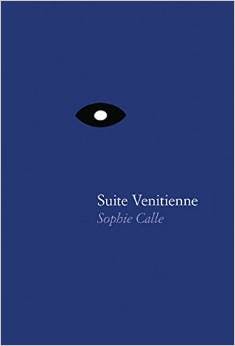
In addition to the insertion of actual art within the novel, many of these reality-fictions feature scenes in museums or at contemporary art exhibitions. The opening scene of Lerner’s Leaving the Atocha Station takes place at the Prado, where the narrator finds the reluctance of the museum guards to close in on an erratic visitor more moving than the actual paintings. Sheila Heti spends three days at Art Basel in How Should a Person Be?, and Michel Houellebecq lampoons the contemporary art world in The Map and the Territory. Siri Hustvedt’s novel What I Loved begins with the discovery of a painting, while her most recent effort, The Blazing World, lays bare the systemic bias against women in the art world. Orhan Pamuk’s The Museum of Innocence literally became a museum in Istanbul.

The art world has seeped into the literary world in other ways. Most art fairs, including Frieze London and Frieze New York, feature talks by writers in their programs. Hustvedt, the author of a well-received book of art criticism as well, has lectured at the Prado and the Met. And in an interview published this spring (also in BOMB), the novelist Tom McCarthy described how falling in with a crowd of visual artists in his twenties gave him a more sophisticated understanding of literature’s possibilities: “These people generally had a much more dynamic engagement with literature than most ‘literary’ people … and their work seemed to be actively addressing the whole legacy of literary modernism (in the same way that Bruce Nauman works through questions posed by Beckett, for example, or Cage with Joyce). … [T]he art world—to a large extent—provides the arena in which literature can be vigorously addressed, transformed, and expanded.”
This literary coalescence around visual art seems increasingly less coincidental and more and more the entire point. The avant-garde writers of today aspire to be conceptual artists, and have their novels considered conceptual art. This may be literature’s Duchampian moment. Welcome to the readymade novel.
Just as Marcel Duchamp asked if a urinal could be art, the readymade novel asks what literature can be, and what it should be in the future. Instead of trying to understand reality via a slew of concrete details, omniscience, multiple viewpoints, or anything else that we’ve traditionally expected from fiction, the readymade novel poses an idea or raises a question. It is more interested in the concept behind a work of art—behind itself—than its execution. The readymade novel underlines the chief virtue (or curse) of conceptual art: Unlike traditional visual art, you don’t actually need to see a readymade to “get it.” But if you do go to see it, it’s just as if you’ve opened up a readymade novel: You’re not merely a passive viewer of art, but an active participant in its formation.
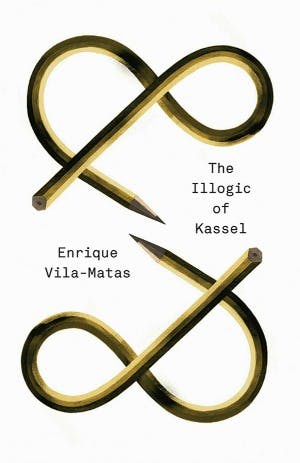
Two newly published books by the Spanish novelist Enrique Vila-Matas show just how deeply this literature-as-conceptual-art trend has permeated avant-garde contemporary literature. In Vila-Matas’ latest novel, The Illogic of Kassel, the writer has literally become a contemporary art exhibition. The novel lightly fictionalizes Vila-Matas’ real-life experience at the Documenta art exhibition in Kassel, Germany, where he was invited to participate in a week-long writer-in-residence program in 2013. The curators of Documenta ask him to spend the week writing in the corner of a small Chinese restaurant. Vila-Matas finds this absurd, and spends most of his time at the (real-life) Dschingis Khan restaurant sleeping, inventing conversations between the German and Chinese people around him, and actively avoiding the one crazy person who approaches him. Despite seemingly wasting his time in the restaurant, Vila-Matas becomes the piece of performance art that the curators of Documenta hoped he would be: “Art is art, and what you make of it is up to you,” one curator tells him.
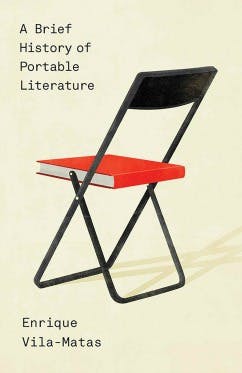
Vila-Matas is also the author of A Brief History of Portable Literature, originally published in 1985 and jointly released this summer with The Illogic of Kassel. A Brief History of Portable Literature is the rawer of the two books, a whimsical romp based on the peregrinations of a secret literary society of “Shandies” (as in Tristram Shandy). It is perhaps best (self-deprecatingly) described within its own pages as “a journey that sought no goal, no fixed object, and was clearly futile.” This book is a catalogue of the avant-garde—with allusions to Duchamp, Walter Benjamin, Man Ray, Georgia O’Keeffe—that is composed in a style that teeters between funny and obnoxiously in-the-know. There is a mockumentary retrospective feel to it: a piecemeal investigation into the events that precipitated the demise of this gloriously short-lived secret society, which required its members to make portable art, i.e., readymades a la Duchamp’s box-in-a-suitcase.
Read together, these two novels, published some 30 years apart, demonstrate the evolution of Vila-Matas’s thinking on the relationship between contemporary art and literature. A Brief History of Portable Literature, on one hand, simply ventriloquizes this gaggle of Duchampian disciples. It’s almost like highbrow fan fiction. But in The Illogic of Kassel, Vila-Matas doesn’t merely tell us how great artists attempted to create portable art—he becomes part of the portable art. Sulking in the Chinese restaurant, writing or merely pretending to do so, Vila-Matas was an official exhibition at Documenta 13, whose Writers’ Residency “sought moments of ‘chorality’: instances of mutual commitment, whether loud or muted; the possibility that voices could meet and join together, without the outright demand that they should.” The concepts or questions—what if we make the solitary act of writing a public performance? Can we have privacy in a public space?—outstrip their execution in importance.
That’s not the sole project of the readymade novel, however: Vila-Matas also reminds us that we don’t live like nineteenth-century French novelists anymore, so we should stop writing according to their demodé, quasi-scientific conventions of realism: “We loath the realist who thinks the task of the writer is to reproduce, copy, imitate reality, as if, in its chaotic evolution, its monstrous complexity, reality could be trapped and narrated,” writes Vila-Matas in The Illogic of Kassel. “We are amazed by writers who believe that the more empirical and prosaic they are, they closer they get to the truth, when in fact the more details you pile up, the further that takes you away from reality.”
Our reality, instead, lies in something more akin to conceptual art. In The Illogic of Kassel, Vila-Matas is fond of repeating a line that Mallarmé told Manet: “Paint, not the thing, but the effect that it produces.” In other words, the effect of art has now become more important than the canvas. It’s not surprising that this line is repeated so often in the novel: In The Illogic of Kassel, Vila-Matas is very much painting the effect that art produces. The reader has unvarnished access to his rich interior life—all his anxieties, opinions, and experiences of viewing installations at Documenta. Indeed, Vila-Matas demands an active reader: Just as the conceptual art installations at Documenta demanded viewer participation to form meaning, Vila-Matas asks the same of his readers. “Art is art, and what you make of it is up to you,” the Documenta curator reminds us. Grapping with competing interpretations, processing your various associations, feelings, and theories—this is the work of art in the new millennium.
The “readymade” writers are, of course, still on the fringes of contemporary literature. Only Pamuk and Sebald are currently internationally famous. Cole and Lerner are on their way to greater recognition, and one hopes their future novels will create more buzz, but Vila-Matas and Zambra will have to wait for more English-language translations of their work to get their proper due; Sophie Calle may be perpetually too avant-garde. Regardless of their varying commercial successes, the emergence of these writers suggests at least a small audience with an interest in how we experience art today. And it seems likely that the younger writers of this generation will continue to write similar books in the future. The “readymade” novelists may inspire a few readymade imitations of their own.
Photo from Suite Vénitienne by Sophie Calle, published by Siglio, 2015. Images and text copyrighted and provided courtesy of the artist.
